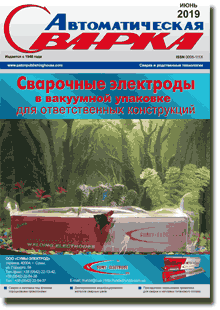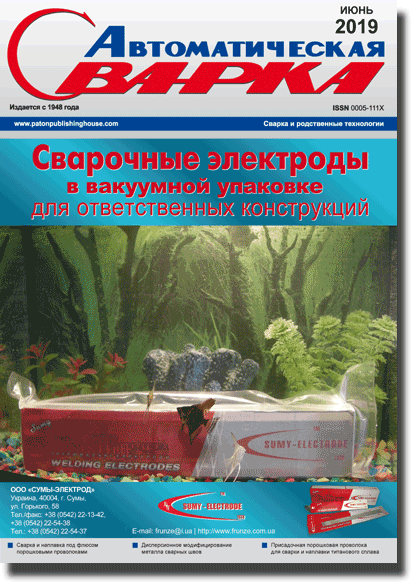| 2019 №06 (09) |
DOI of Article 10.15407/as2019.06.10 |
2019 №06 (11) |

Avtomaticheskaya Svarka (Automatic Welding), #6, 2019, pp.60-64
Peculiarities of welding process using metal flux-cored wire of grade TMV5-MK
A.A. Golyakevich1, L.N. Orlov1, S.Yu. Maximov2
1LLC «ТМ.VELTEK». 15 Kazimir Malevich Str., 03150, Kyiv, Ukraine. E-mail: office@veldtec.ua
2E.O. Paton Electric Welding Institute of the NAS of Ukraine. 11 Kazimir Malevich Str., 03150, Kyiv, Ukraine. E-mail: office@paton.kiev.ua
Currently, in the world market of welding consumables there is a steady trend in growing consumption of flux-cored wires. One of the rapidly developing technologies for manufacture of metal structures is arc welding in shielding gases using flux-cored wire with a metal core. The metal flux-cored wires as to the technology of application do not differ from the wires of solid section, and as to the number of technological characteristics they even surpass them. Taking into account the global trends in the development of mechanized welding and the lack of domestic analogues, LLC «TM.VELTEK» developed and mastered the production of high-performance metal flux-cored wire TMV5-MK for welding in a mixture of 82% Ar + 18% CO2. It was established that metal flux-cored wire provides a high stability of arc burning in a wide range of welding conditions. Using the wire of solid section Sv-08G2S in welding at the same modes in the optimal range, the value of stability of arc burning is 3 times lower as compared to the metal flux-cored wire TMV5-MK. It is shown that the stability of welding process is significantly influenced by electrodynamic properties of the power source and this factor should be taken into account during evaluation of welding and technological properties of welding wires and development of recommendations for their application. 8 Ref., 1 Tabl., 4 Fig.
Key words: metal flux-cored wire, wire of solid section, power source, stability of arc burning, short circuit
Received: 17.04.2019
Published: 20.05.2019
References
1. Mazur, A.A., Makovetskaya, O.K., Pustovojt, S.V., Brovchenko, N.S. (2015) Metal cored wires at the world and regional markets of welding consumables (Review). The Paton Welding J., 5-6, 63-69. https://doi.org/10.15407/tpwj2015.06.152. Shlepakov, V.N., Gavrilyuk, U.A., Kotelchuk, A.S. (2010) State-of-the-art of development and application of flux-cored wires for welding of carbon and low-alloyed steels. Ibid., 3, 38-42.
3. Rosert, R., Karasyov, M.V. (2012) Metal cored wires: tendencies, development and their application in industry. In: Proc. of St.-Petersburg Int. Conf. on Welding Consumables -2012 to 100th Anniversary of TsNIIM (Russian, St.-Petersburg, 16-18 October, 2012), 220-230.
4. Karasyov, M.V., Rabotinsky, D.N., Alimov, A.N. et al. (2008) Welding of butt joints of bridge structures and pipelines using metal cored wire and equipment for metal transfer control. The Paton Welding J., 10, 42-45.
5. Metal cored wire OUTERSHIELD®. https:www.lincolnelectric.com/ruru/support/process-and-theory/Pages/metal cored-wires.aspx.
6. Advantages and disadvantages of metal cored wires. http://www.esabna.com./us/en/education/blog/advantages-anddisadvantages-of-metal cored-wires.cfm
7. Gas-arc welding of metal structures by metal cored wire withmetal core. http://www.spetselectrode.ru/download/2017-Gazoelectricheskaya-svarka-metallokonstrukciyporoshkovoy-provolokoy-s-metallicheskim-serdechnikom/1.htm
8. Pirumov, A.E., Skachkov, I.O., Suprun, S.A., Maksimov, Yu.S. (2007) Specialized information-measuring system for monitoring the process of arc welding. The Paton Welding J., 8, 34-36.
The cost of subscription/purchase order journals or individual articles
| Journal/Currency | Annual Set | 1 issue printed |
1 issue |
one article |
| TPWJ/USD | 384 $ | 32 $ | 26 $ | 13 $ |
| TPWJ/EUR | 348 € | 29 € | 24 € | 12 € |
| TPWJ/UAH | 7200 UAH | 600 UAH | 600 UAH | 280 UAH |
| AS/UAH | 1800 UAH | 300 UAH | 300 UAH | 150 UAH |
| AS/USD | 192 $ | 32 $ | 26 $ | 13 $ |
| AS/EUR | 180 € | 30 € | 25 € | 12 € |
| SEM/UAH | 1200 UAH | 300 UAH | 300 UAH | 150 UAH |
| SEM/USD | 128 $ | 32 $ | 26 $ | 13 $ |
| SEM/EUR | 120 € | 30 € | 25 € | 12 € |
| TDNK/UAH | 1200 UAH | 300 UAH | 300 UAH | 150 UAH |
| TDNK/USD | 128 $ | 32 $ | 26 $ | 13 $ |
| TDNK/EUR | 120 € | 30 € | 25 € | 15 € |
AS = «Automatic Welding» - 6 issues per year;
TPWJ = «PATON WELDING JOURNAL» - 12 issues per year;
SEM = «Electrometallurgy Today» - 4 issues per year;
TDNK = «Technical Diagnostics and Non-Destructive Testing» - 4 issues per year.





